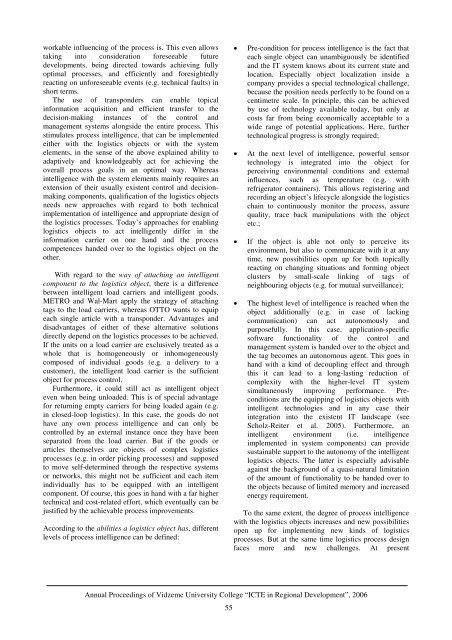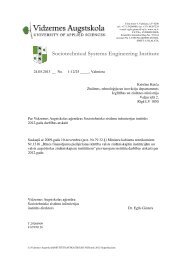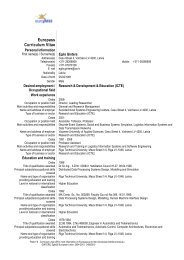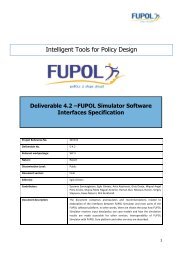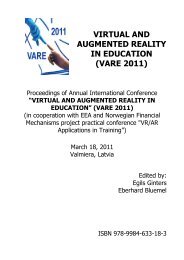Proceedings in pdf format. - Sociotechnical Systems Engineering ...
Proceedings in pdf format. - Sociotechnical Systems Engineering ...
Proceedings in pdf format. - Sociotechnical Systems Engineering ...
You also want an ePaper? Increase the reach of your titles
YUMPU automatically turns print PDFs into web optimized ePapers that Google loves.
workable <strong>in</strong>fluenc<strong>in</strong>g of the process is. This even allowstak<strong>in</strong>g <strong>in</strong>to consideration foreseeable futuredevelopments, be<strong>in</strong>g directed towards achiev<strong>in</strong>g fullyoptimal processes, and efficiently and foresightedlyreact<strong>in</strong>g on unforeseeable events (e.g. technical faults) <strong>in</strong>short terms.The use of transponders can enable topical<strong>in</strong><strong>format</strong>ion acquisition and efficient transfer to thedecision-mak<strong>in</strong>g <strong>in</strong>stances of the control andmanagement systems alongside the entire process. Thisstimulates process <strong>in</strong>telligence, that can be implementedeither with the logistics objects or with the systemelements, <strong>in</strong> the sense of the above expla<strong>in</strong>ed ability toadaptively and knowledgeably act for achiev<strong>in</strong>g theoverall process goals <strong>in</strong> an optimal way. Whereas<strong>in</strong>telligence with the system elements ma<strong>in</strong>ly requires anextension of their usually existent control and decisionmak<strong>in</strong>gcomponents, qualification of the logistics objectsneeds new approaches with regard to both technicalimplementation of <strong>in</strong>telligence and appropriate design ofthe logistics processes. Today’s approaches for enabl<strong>in</strong>glogistics objects to act <strong>in</strong>telligently differ <strong>in</strong> the<strong>in</strong><strong>format</strong>ion carrier on one hand and the processcompetences handed over to the logistics object on theother.With regard to the way of attach<strong>in</strong>g an <strong>in</strong>telligentcomponent to the logistics object, there is a differencebetween <strong>in</strong>telligent load carriers and <strong>in</strong>telligent goods.METRO and Wal-Mart apply the strategy of attach<strong>in</strong>gtags to the load carriers, whereas OTTO wants to equipeach s<strong>in</strong>gle article with a transponder. Advantages anddisadvantages of either of these alternative solutionsdirectly depend on the logistics processes to be achieved.If the units on a load carrier are exclusively treated as awhole that is homogeneously or <strong>in</strong>homogeneouslycomposed of <strong>in</strong>dividual goods (e.g. a delivery to acustomer), the <strong>in</strong>telligent load carrier is the sufficientobject for process control.Furthermore, it could still act as <strong>in</strong>telligent objecteven when be<strong>in</strong>g unloaded. This is of special advantagefor return<strong>in</strong>g empty carriers for be<strong>in</strong>g loaded aga<strong>in</strong> (e.g.<strong>in</strong> closed-loop logistics). In this case, the goods do nothave any own process <strong>in</strong>telligence and can only becontrolled by an external <strong>in</strong>stance once they have beenseparated from the load carrier. But if the goods orarticles themselves are objects of complex logisticsprocesses (e.g. <strong>in</strong> order pick<strong>in</strong>g processes) and supposedto move self-determ<strong>in</strong>ed through the respective systemsor networks, this might not be sufficient and each item<strong>in</strong>dividually has to be equipped with an <strong>in</strong>telligentcomponent. Of course, this goes <strong>in</strong> hand with a far highertechnical and cost-related effort, which eventually can bejustified by the achievable process improvements.Accord<strong>in</strong>g to the abilities a logistics object has, differentlevels of process <strong>in</strong>telligence can be def<strong>in</strong>ed:• Pre-condition for process <strong>in</strong>telligence is the fact thateach s<strong>in</strong>gle object can unambiguously be identifiedand the IT system knows about its current state andlocation. Especially object localization <strong>in</strong>side acompany provides a special technological challenge,because the position needs perfectly to be found on acentimetre scale. In pr<strong>in</strong>ciple, this can be achievedby use of technology available today, but only atcosts far from be<strong>in</strong>g economically acceptable to awide range of potential applications. Here, furthertechnological progress is strongly required;• At the next level of <strong>in</strong>telligence, powerful sensortechnology is <strong>in</strong>tegrated <strong>in</strong>to the object forperceiv<strong>in</strong>g environmental conditions and external<strong>in</strong>fluences, such as temperature (e.g. withrefrigerator conta<strong>in</strong>ers). This allows register<strong>in</strong>g andrecord<strong>in</strong>g an object’s lifecycle alongside the logisticscha<strong>in</strong> to cont<strong>in</strong>uously monitor the process, assurequality, trace back manipulations with the objectetc.;• If the object is able not only to perceive itsenvironment, but also to communicate with it at anytime, new possibilities open up for both topicallyreact<strong>in</strong>g on chang<strong>in</strong>g situations and form<strong>in</strong>g objectclusters by small-scale l<strong>in</strong>k<strong>in</strong>g of tags ofneighbour<strong>in</strong>g objects (e.g. for mutual surveillance);• The highest level of <strong>in</strong>telligence is reached when theobject additionally (e.g. <strong>in</strong> case of lack<strong>in</strong>gcommunication) can act autonomously andpurposefully. In this case, application-specificsoftware functionality of the control andmanagement system is handed over to the object andthe tag becomes an autonomous agent. This goes <strong>in</strong>hand with a k<strong>in</strong>d of decoupl<strong>in</strong>g effect and throughthis it can lead to a long-last<strong>in</strong>g reduction ofcomplexity with the higher-level IT systemsimultaneously improv<strong>in</strong>g performance. Preconditionsare the equipp<strong>in</strong>g of logistics objects with<strong>in</strong>telligent technologies and <strong>in</strong> any case their<strong>in</strong>tegration <strong>in</strong>to the existent IT landscape (seeScholz-Reiter et al. 2005). Furthermore, an<strong>in</strong>telligent environment (i.e. <strong>in</strong>telligenceimplemented <strong>in</strong> system components) can providesusta<strong>in</strong>able support to the autonomy of the <strong>in</strong>telligentlogistics objects. The latter is especially advisableaga<strong>in</strong>st the background of a quasi-natural limitationof the amount of functionality to be handed over tothe objects because of limited memory and <strong>in</strong>creasedenergy requirement.To the same extent, the degree of process <strong>in</strong>telligencewith the logistics objects <strong>in</strong>creases and new possibilitiesopen up for implement<strong>in</strong>g new k<strong>in</strong>ds of logisticsprocesses. But at the same time logistics process designfaces more and new challenges. At presentAnnual <strong>Proceed<strong>in</strong>gs</strong> of Vidzeme University College “ICTE <strong>in</strong> Regional Development”, 200655


